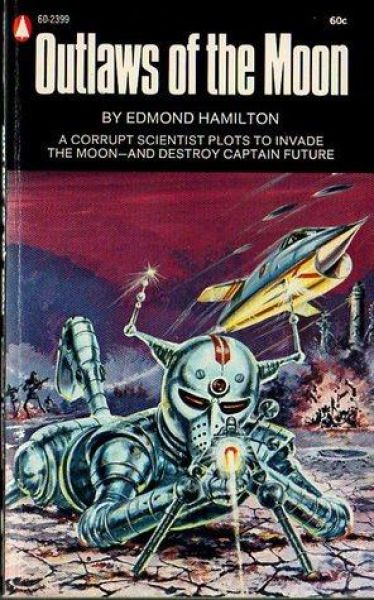Have No Fear of the Bayin’ Hounds
Outlaws of the Moon (Captain Future, volume 10)
By Edmond Hamilton

6 May, 2018
Edmond Hamilton’s 1942 Outlaws of the Moon is the tenth volume in the Captain Future series.
Curt “Captain Future” Newton, android Otho, robot Grag, and living-brain-in-a-box Simon “The Brain” Wright ventured into deepest space in quest of a secret that could save dying Mercury. For fear of raising false hopes, Newton kept the mission secret. Enough time has elapsed since anyone has seen Newton and his Futuremen1 that the Solar System has concluded that Newton and his chums must be dead.
On the plus side, this means that the secrets of Newton’s hidden lunar laboratory are open to anyone who can find it. Corrupt scientist Wissler is certain he knows how to do so. The Moon is notoriously deficient in useful minerals, including radium. All Wissler needs to do is look for concentrations of radium. Radium in sufficient amounts to show up on a detector must be Captain Future’s private radium stock.
Well, no. Wissler does find radium but not where he expects to find it. Captain Future, it seems, lied about the Moon’s mineral resources.
[spoiler warning]
Obtaining mining rights to the veritable mountain of radium Wissler detected deep within the Moon means abrogating Curt Newton’s property rights to the Moon and its resources. Wissler will need help to do this. He turns to sleazy promoter Larsen King, a man with connections. The gambit might just reduce Wissler to a bit player in his own scheme, but he decides that the potential riches justify the risk.
By the time Captain Future, Grag, Otho, and the Brain return from their interstellar mission, their reputation has been sullied, their Moon-monopoly broken, and a mining town has been built on the airless surface of the Moon. But … the miners have yet to reach the radium. There may still be time for Curt to convince System Government President James Carthew that the radium needs to be reserved for future use.
Unfortunately for Curt and doubly-so for poor President Carthew, mastermind King has foreseen that Curt might try to use his friendship with Carthew. No sooner do Newton and Carthew meet than Newton finds himself framed for the murder of beloved President Carthew! Now the Futuremen are not merely despised radium hoarders. They’re wanted criminals with the Patrol dogging their heels.
~oOo~
Crooked businessmen sure suck! But at least we live in a world where it is impossible for a small handful of plutocrats to convince the masses that lies are truth.
For a book of this vintage, the plot is considerably less genocide-positive than I expected (expectations derived from Hamilton’s Space Patrol stories, which mostly involved the Patrol helping various dying races all the way into extinction). In the course of the novel, the adventurers encounter a lost civilization, one dependent on resources that the industrialized worlds need. It probably would not have been hard to sell readers of 1940 that the advanced cultures had every right to commandeer the resources from technologically backward cultures — but that is not the direction the author chooses to go. Thank Ghu.
Although it was clear by 1940 that most of the planets of the Solar System could not possibly be habitable, the Captain Future setting (created by Mort Weisinger and developed by Hamilton and other authors) assumes that each world, from Jupiter to tiny Eros, has or at least had its own native humanoid population. In cases where there is no known current population, odds are the world had one in the past. Case in point: the Moon, whose surface bears relics of a Lunarian civilization doomed as its air drained down into the Moon. As air apparently does in this setting.
The public of this novel sure seems a fickle lot. Curt and his mentors/flunkies may have saved the Solar System on a number of occasions, but that doesn’t matter once there is a possibility of mucho radium. In the public’s defence, if Curt’s actions in this book are any guide, he and his chums are awfully casual about the side-effects of their bold gambits. Not to give too much away, but … at one point Curt suppresses all atomic power on the Moon and the Earth as well.
Earth was a world without power, all its industries and utilities frozen, its transport inoperative, its spaceships pinned down, unable to take off into space. Earth — isolated from the entire Solar System.
Best not to wonder how many people died when every flying machine on the planet found itself without power.
Curt clears his name by revealing that a man he has just killed has in his pocket the original voice recording from the President’s office. If there’s anything more convincing than finding the very recording one needs in the possession of an enemy no longer able to speak in his own defence because one has inadvertently punched him to death, I sure don’t know what that would be.
Outlaws of the Moon was the first Captain Future novel I encountered. It was also the last one; even by 1970 it was hopelessly dated.
Outlaws of the Moon is available here (Amazon). It does not appear to be available from Chapters-Indigo.
1: The book is rather vague on just how long they’ve been gone. Passages like
(…) a small ship was racing Sunward. It moved at a speed approaching the velocity of light, yet in these great deeps it seemed only to be crawling.
suggest that it could have been decades or more, However, as the cast of minor supporting characters didn’t age to death while the Futuremen were travelling in interstellar spaces, either faster-than-light travel was invoked or Hamilton treated relativity with the same respect that he gave to planetary science.
